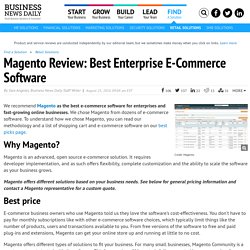

The pros and cons of Magento. It’s rich in features and there is a broad Magento community, but it may be too expensive and complex for smaller retailers.

When it comes to launching an e-commerce site, one of the most significant decisions for every online business is made well before the website ever takes shape. It centers on the commitment to delivering a superior customer experience, one that converts casual shoppers into loyal customers. If you’re considering an online presence for your business, you need to have a clear answer to this important question—Which e-commerce platform do I want powering my site? This seems like a fairly simple question, right? False. Through my years of experience working within e-commerce I have found Magento to be the most efficient e-commerce platform. There are five features I strongly believe that help Magento stand out from the rest: Catalog Management: Uploading products one by one to an online store is a time-consuming task for businesses selling even just a few products.
Magento Is A Strong Choice For A Mobile eCommerce World. [Guest post by Graeme Caldwell from Nexcess] Mobile eCommerce is likely to become the dominant online shopping experience.

Magento’s responsive eCommerce design is the optimal mobile eCommerce solution. Just a few years ago, mobile eCommerce wasn’t on most retailers radar. The world has changed. Smartphones and tablets are everywhere. There are several options open to eCommerce retailers: They can ignore mobile and rely on traditional eCommerce solutions that assume large screens and pointer-based interfaces.They can invest in creating apps for the various mobile platforms. How to make the most of Magento in your e-commerce store. The wide range of tools available, and the customisation opportunities it provides, can all be implemented in your store to transform the way you do business and improve your bottom line.

When you think about e-commerce platforms, Magento is most likely one of the first that springs to mind. Its footprints can be found across the web, and it powers the most merchants in Internet Retailer’s top 1000, more than double of any other provider. Until recently owned and operated by eBay Enterprise and now spun off as an independent entity, Magento is one of the world’s leading e-commerce platforms, the number one choice for both small start-up businesses and well-established commercial juggernauts. And yet, many e-commerce stores that use Magento are simply not taking full advantage of everything it has to offer. Its open source technology offer merchants huge flexibility, not just in terms of the look and the content of their store front, but also in how their shopping cart functions.
Magento Review: Best Enterprise E-Commerce Software. Credit: Magento We recommend Magento as the best e-commerce software for enterprises and fast-growing online businesses.

6 Features That Make Magento One of the Best eCommerce Platforms Around. One of the many things that gives Magento an edge over other eCommerce platforms is the large array of features it comes loaded with.

Called the “platform for growth”, Magento is famous for its flexibility, scalability, and robustness that has also been praised by experts in the eCommerce industry. Created to serve the dynamic needs of eCommerce businesses and marketers all over the world, Magento has made a special place in the industry because of the features it offers and the endless possibilities it brings to your business as it strives to gain a competitive edge in the market. Here’s a look at some of the top features of Magento that you can add to your e-store and turn it into a highly secure, user-friendly, and attractive online shopping experience. 1. Setting Variable Prices for Select Customers: We’re living in a time when customers have a ton of options to choose from while shopping around if they don’t like the price offered. 2. 3. 4. 5. 6.
Like this: Like Loading...